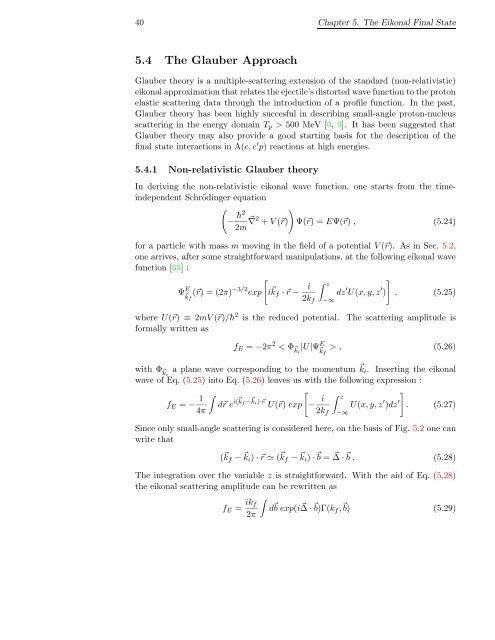Download Thesis in Pdf Format - Theoretical Nuclear Physics and ...
Download Thesis in Pdf Format - Theoretical Nuclear Physics and ...
Download Thesis in Pdf Format - Theoretical Nuclear Physics and ...
Create successful ePaper yourself
Turn your PDF publications into a flip-book with our unique Google optimized e-Paper software.
40 Chapter 5. The Eikonal F<strong>in</strong>al State<br />
5.4 The Glauber Approach<br />
Glauber theory is a multiple-scatter<strong>in</strong>g extension of the st<strong>and</strong>ard (non-relativistic)<br />
eikonal approximation that relates the ejectile’s distorted wave function to the proton<br />
elastic scatter<strong>in</strong>g data through the <strong>in</strong>troduction of a profile function. In the past,<br />
Glauber theory has been highly succesful <strong>in</strong> describ<strong>in</strong>g small-angle proton-nucleus<br />
scatter<strong>in</strong>g <strong>in</strong> the energy doma<strong>in</strong> T p > 500 MeV [6, 9]. It has been suggested that<br />
Glauber theory may also provide a good start<strong>in</strong>g basis for the description of the<br />
f<strong>in</strong>al state <strong>in</strong>teractions <strong>in</strong> A(e, e ′ p) reactions at high energies.<br />
5.4.1 Non-relativistic Glauber theory<br />
In deriv<strong>in</strong>g the non-relativistic eikonal wave function, one starts from the time<strong>in</strong>dependent<br />
Schröd<strong>in</strong>ger equation<br />
(<br />
)<br />
− ¯h2 ∇<br />
2m ⃗ 2 + V (⃗r) Ψ(⃗r) = EΨ(⃗r) , (5.24)<br />
for a particle with mass m mov<strong>in</strong>g <strong>in</strong> the field of a potential V (⃗r). As <strong>in</strong> Sec. 5.2,<br />
one arrives, after some straightforward manipulations, at the follow<strong>in</strong>g eikonal wave<br />
function [63] :<br />
[<br />
Ψ⃗ E kf<br />
(⃗r) = (2π) −3/2 exp i ⃗ k f · ⃗r −<br />
i ∫ ]<br />
z<br />
dz ′ U(x, y, z ′ ) , (5.25)<br />
2k f −∞<br />
where U(⃗r) ≡ 2mV (⃗r)/¯h 2 is the reduced potential.<br />
formally written as<br />
The scatter<strong>in</strong>g amplitude is<br />
f E = −2π 2 < Φ ⃗ki |U|Ψ E ⃗ kf<br />
> , (5.26)<br />
with Φ ⃗ki a plane wave correspond<strong>in</strong>g to the momentum ⃗ k i . Insert<strong>in</strong>g the eikonal<br />
wave of Eq. (5.25) <strong>in</strong>to Eq. (5.26) leaves us with the follow<strong>in</strong>g expression :<br />
f E = − 1 ∫<br />
[<br />
d⃗r e i(⃗ k f − ⃗ k i )·⃗r U(⃗r) exp − i ∫ ]<br />
z<br />
U(x, y, z ′ )dz ′ . (5.27)<br />
4π<br />
2k f −∞<br />
S<strong>in</strong>ce only small-angle scatter<strong>in</strong>g is considered here, on the basis of Fig. 5.2 one can<br />
write that<br />
( ⃗ k f − ⃗ k i ) · ⃗r ≃ ( ⃗ k f − ⃗ k i ) ·⃗b = ⃗ ∆ ·⃗b . (5.28)<br />
The <strong>in</strong>tegration over the variable z is straightforward. With the aid of Eq. (5.28)<br />
the eikonal scatter<strong>in</strong>g amplitude can be rewritten as<br />
f E = ik ∫<br />
f<br />
d<br />
2π<br />
⃗ b exp(i∆ ⃗ ·⃗b)Γ(k f , ⃗ b) (5.29)















